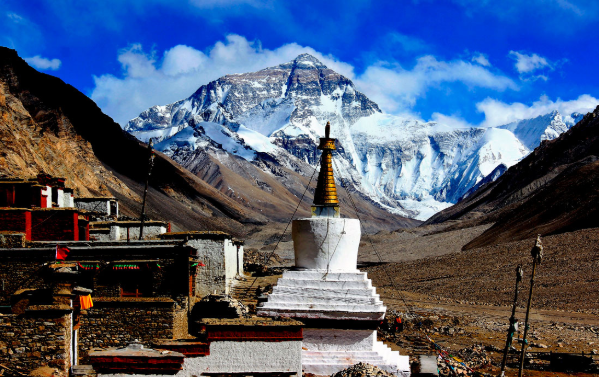The Tibet Everest Base Camp Tour is one of the most breathtaking adventures on the planet, offering travelers the rare opportunity to stand face-to-face with Mount Everest (8,848.86 m) from the northern side. Set in the mystical land of Tibet—often called the “Roof of the World”—this journey combines awe-inspiring natural beauty, deep spiritual heritage, and a glimpse into the heart of Tibetan culture.
For adventure seekers, photographers, and spiritual travelers, this tour is more than a trip—it’s an unforgettable life experience that connects you with the power and serenity of the Himalayas.
Introduction to the Tibet Everest Base Camp Tour
Unlike the Everest Base Camp trek in Nepal, the Tibet Everest Base Camp (EBC) Tour is accessible by road, making it an ideal option for those who wish to witness the grandeur of Everest without several days of trekking. Starting from Lhasa, the spiritual capital of Tibet, the journey leads through high passes, turquoise lakes, and ancient monasteries before reaching the Everest Base Camp (5,200 meters) in Rongbuk Valley.
This tour blends natural splendor with rich cultural encounters, offering travelers the chance to explore Tibet’s sacred landmarks, including Potala Palace, Jokhang Temple, Yamdrok Lake, and Rongbuk Monastery, the highest monastery in the world.
Highlights of the Tibet Everest Base Camp Tour
- Visit Lhasa, the spiritual heart of Tibet, and explore UNESCO World Heritage Sites like the Potala Palace and Jokhang Temple.
- Drive through the breathtaking Himalayan landscape along the Friendship Highway.
- Stop at the crystal-clear Yamdrok Lake, one of Tibet’s three holy lakes.
- Explore ancient monasteries such as Gyantse Kumbum, Tashilhunpo, and Rongbuk Monastery.
- Witness the majestic Mount Everest from its north face at Everest Base Camp (5,200 m).
- Experience authentic Tibetan culture, traditions, and high-altitude lifestyle.
Route Overview: From Lhasa to Everest Base Camp
Most tours begin in Lhasa (3,650 m), where travelers spend two days acclimatizing to the altitude and exploring the city’s cultural landmarks. Afterward, the journey continues overland via the Friendship Highway, leading westward toward the Everest region.
Day 1–2: Lhasa Sightseeing and Acclimatization
Explore the Potala Palace, once the winter residence of the Dalai Lama, and visit Jokhang Temple, Tibet’s holiest shrine. Wander through the Barkhor Street market, where pilgrims circumambulate the temple and traders sell prayer flags, incense, and souvenirs.
Day 3: Lhasa to Gyantse (3,950 m) via Yamdrok Lake
The scenic drive passes Kamba La Pass (4,794 m), offering panoramic views of Yamdrok Lake, a turquoise jewel surrounded by snow peaks. Continue to Gyantse, known for the Kumbum Stupa and Pelkor Monastery.
Day 4: Gyantse to Shigatse (3,900 m)
Drive to Shigatse, Tibet’s second-largest city, and visit Tashilhunpo Monastery, the traditional seat of the Panchen Lama.
Day 5: Shigatse to Shegar or Rongbuk (4,980 m)
Travel across high mountain passes like Gyatso La (5,220 m) and enjoy sweeping Himalayan vistas before reaching Rongbuk Valley, the gateway to Everest Base Camp.
Day 6: Visit Everest Base Camp (5,200 m)
From Rongbuk Monastery, a short drive or walk brings you to the Tibet Everest Base Camp—a once-in-a-lifetime viewpoint offering an up-close look at the world’s tallest mountain. The view of Everest’s North Face is unmatched in its grandeur.
Day 7–8: Return to Shigatse and Lhasa
After enjoying sunrise at Everest, drive back to Shigatse and onward to Lhasa, completing your high-altitude Himalayan adventure.
Best Time for the Tibet Everest Base Camp Tour
The best seasons for the Tibet Everest Base Camp Tour are spring (April–June) and autumn (September–October).
- Spring: Clear skies, pleasant temperatures, and unobstructed mountain views. Perfect for photography.
- Autumn: Crisp weather, fewer tourists, and stunning golden landscapes.
- Winter (November–February): Cold but clear, with fewer crowds—ideal for those seeking solitude.
- Monsoon (July–August): The least recommended time due to rain and possible road disruptions.
Permits and Travel Requirements
Traveling to Tibet requires several permits in addition to a Chinese visa. These are usually arranged through a registered Tibetan tour operator.
- Chinese Tourist Visa – Obtainable from a Chinese Embassy before arrival.
- Tibet Travel Permit (TTP) – Mandatory for all foreigners to enter Tibet.
- Alien Travel Permit – Required for regions outside Lhasa, including Everest Base Camp.
- Military Permit – Needed for restricted border areas.
Independent travel is not allowed in Tibet; all visitors must join an organized tour with a licensed Tibetan guide.
Accommodation and Meals
Accommodation during the tour ranges from comfortable hotels in Lhasa and Shigatse to basic guesthouses near Everest Base Camp. Facilities become more limited at higher altitudes, especially around Rongbuk, where rooms are simple but cozy.
Meals include Tibetan and Chinese cuisine—rice, noodles, soups, and dumplings are staples. Vegetarian options are available, though choices become limited closer to EBC. Carrying snacks and hot drinks can be helpful.
Cultural and Spiritual Experience
One of the greatest rewards of the Tibet Everest Base Camp Tour is immersing yourself in the rich Buddhist culture. You’ll see prayer wheels spinning, monks chanting in monasteries, and colorful prayer flags fluttering in the mountain breeze.
In Lhasa, the Potala Palace and Jokhang Temple symbolize Tibet’s spiritual identity, while Rongbuk Monastery, near Everest, stands as a testament to the resilience of faith at extreme altitudes. Meeting local Tibetans and observing their devotion provides profound insight into their peaceful, spiritual lifestyle.
Altitude and Acclimatization
The journey reaches elevations over 5,000 meters, so proper acclimatization is crucial. Spending at least two nights in Lhasa before heading to higher altitudes helps minimize the risk of Acute Mountain Sickness (AMS).
Tips to prevent AMS:
- Ascend gradually and stay hydrated.
- Avoid alcohol and smoking.
- Carry medication such as Diamox if recommended by your doctor.
- Inform your guide if you feel dizziness or shortness of breath.
Essential Travel Tips
- Pack for all weather: Temperatures can vary greatly between day and night.
- Bring warm clothing, sunglasses, sunscreen, and a hat for high-altitude exposure.
- Carry cash (CNY): ATMs are only available in Lhasa and Shigatse.
- Photography: Always ask permission before photographing locals or monks.
- Stay respectful: Follow local customs in monasteries—remove hats, walk clockwise, and avoid touching sacred objects.
Why Choose the Tibet Everest Base Camp Tour
The Tibet Everest Base Camp Tour offers a different perspective of the world’s tallest mountain compared to the Nepal side. From the Tibetan plateau, travelers can enjoy an unobstructed, panoramic view of Everest’s North Face—a majestic sight often hidden in clouds on the southern approach.
In addition to Everest, the journey unveils Tibet’s cultural treasures, timeless spirituality, and awe-inspiring landscapes that stretch as far as the eye can see. It’s a unique combination of adventure, culture, and personal reflection that few destinations in the world can match.
Conclusion
The Tibet Everest Base Camp Tour is not just a road trip—it’s a spiritual and emotional journey to one of Earth’s most extraordinary places. From the sacred streets of Lhasa to the windswept plains of the Himalayas, every mile offers a new revelation of beauty, faith, and endurance.
Standing at the Tibet Everest Base Camp Tour, gazing up at the world’s highest peak, travelers often feel a deep sense of humility and wonder. It’s an experience that stays with you forever—a reminder of the vastness of nature and the strength of the human spirit.
If you’re seeking a journey that blends adventure with cultural discovery, the Tibet Everest Base Camp Tour is truly the ultimate Himalayan experience.




